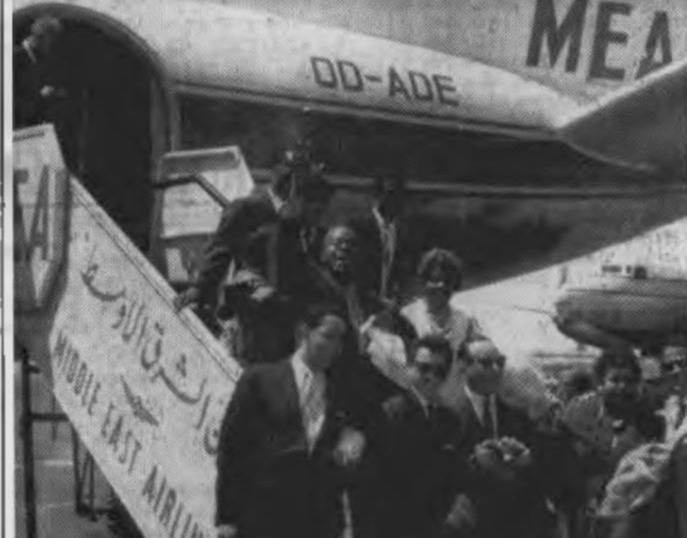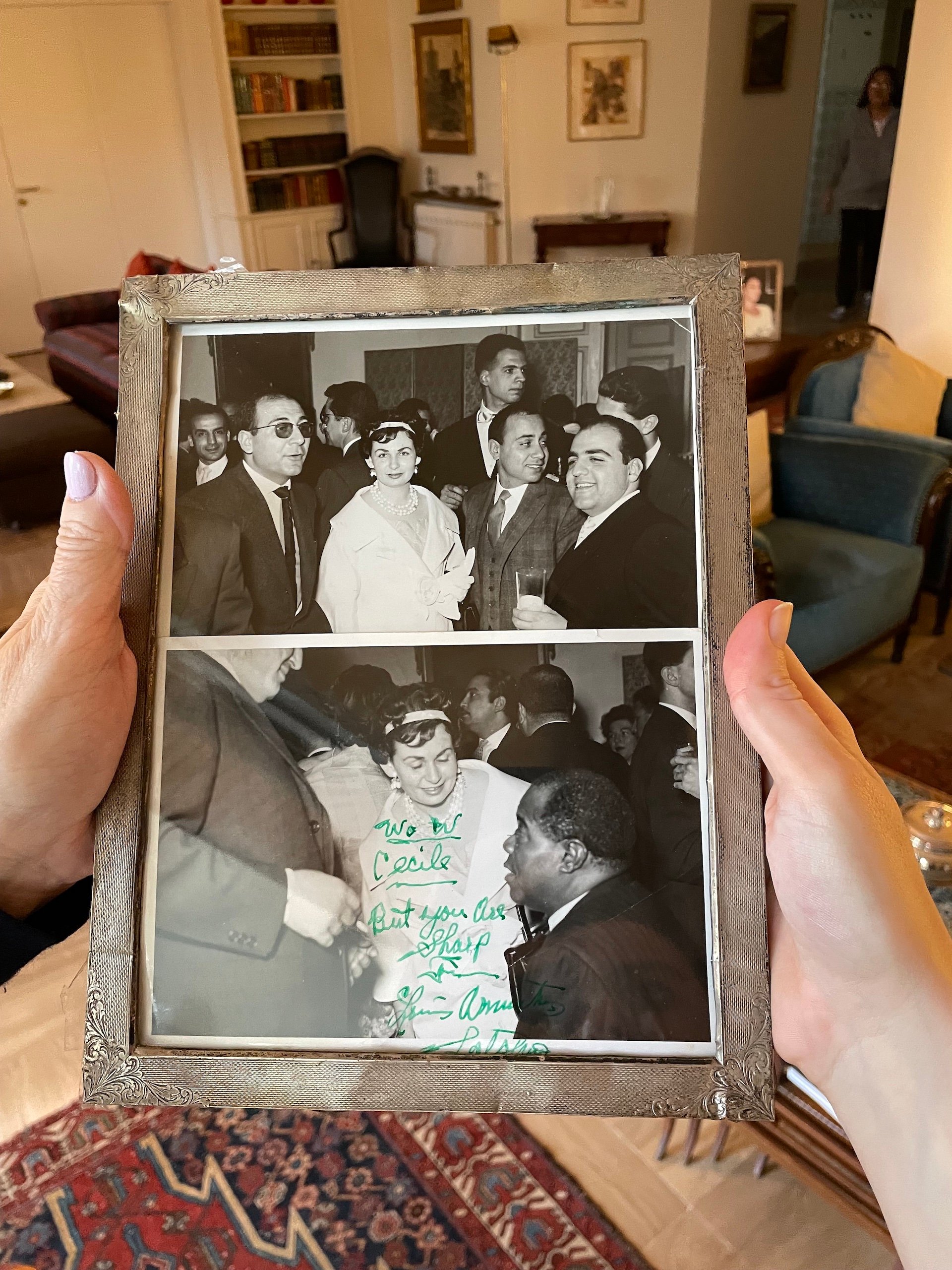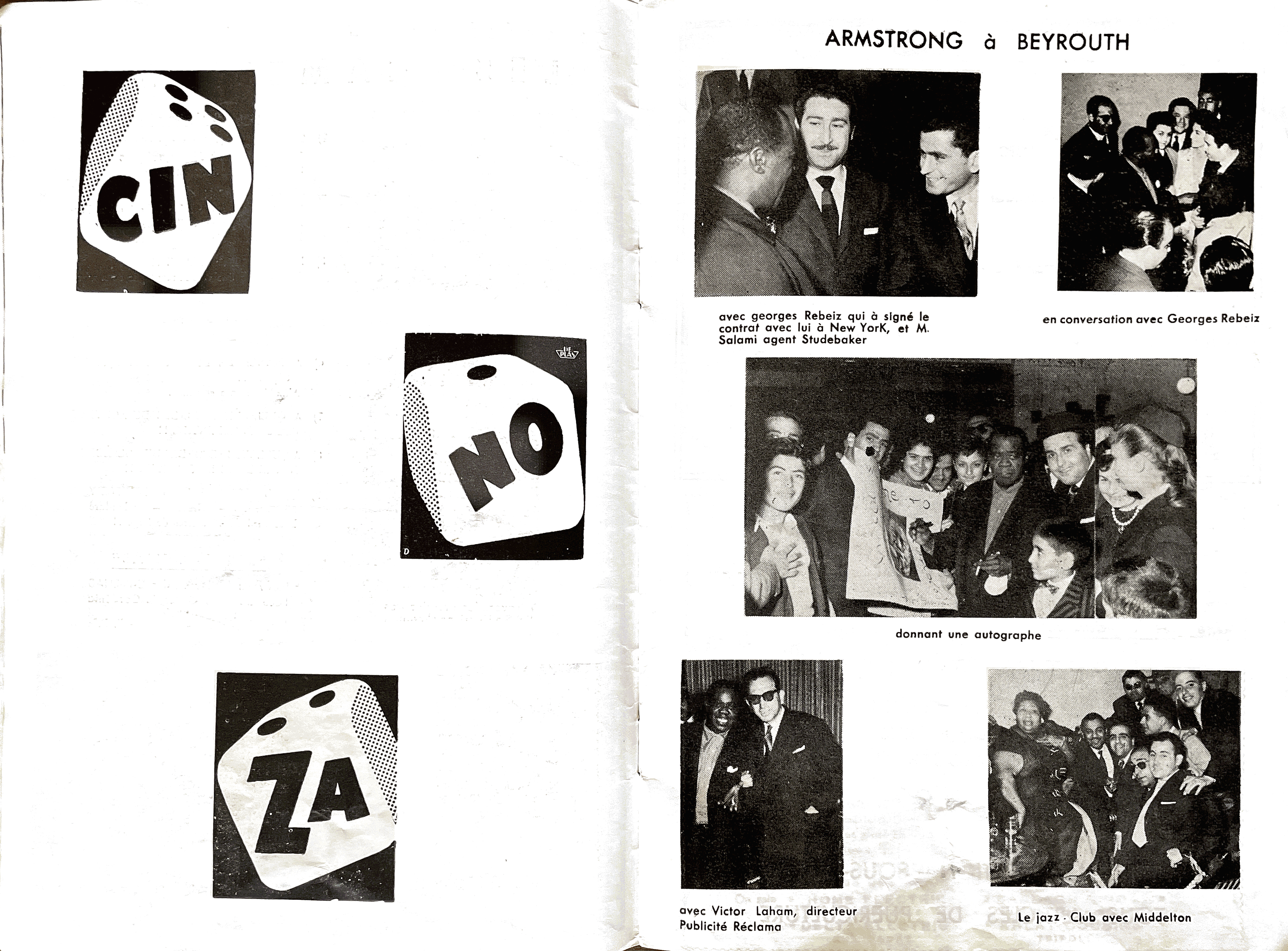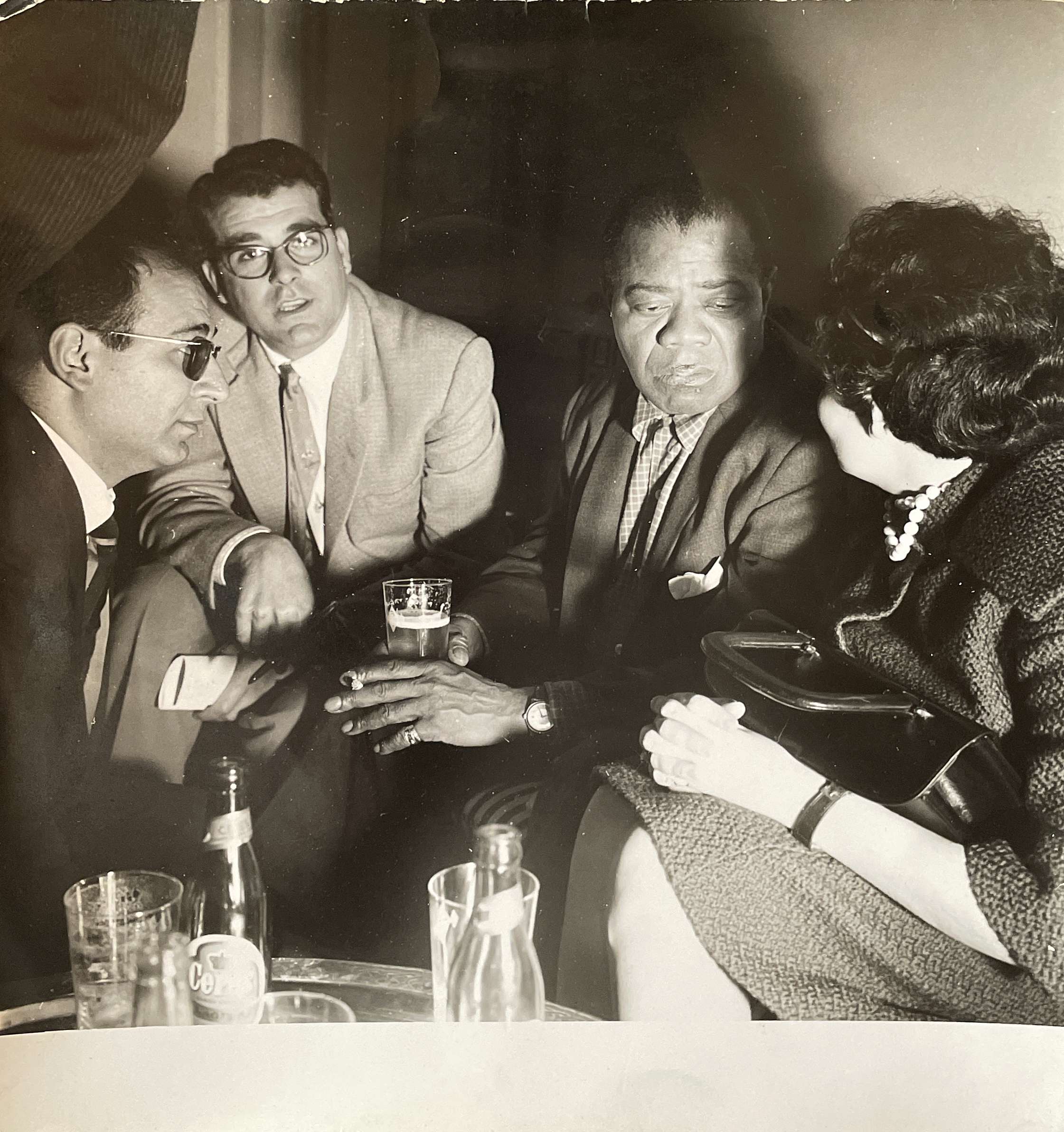
Louis Armstrong arrived at the Beirut Airport along with his wife, Lucille and the rest of his crew.
Photos and audio courtesy of the Louis Armstrong House Museum in New York
Beirut, the 1950s. In the Zeitouna district by the sea, and in the glitzy hotels, jazz music was king, brought in via radio sets in the 40s. There, venues brought in jazz musicians from around the world — that is, according to Youssef Naim, founder of the Beirut Jazz Society.
Among the stars of the day, of course: Louis Armstrong and his All-Stars band.
They were invited to Beirut by the then-businessman and jazz enthusiast George Rbeiz, to perform a series of sold-out shows at the Unesco Theatre from April 6 to April 9, 1959, leaving an indelible mark on the city's cultural landscape.
The newspapers featured Louis Armstrong's imminent arrival in Beirut as front-page news for a whole month leading up to his visit.
 Pictures at the airport welcoming, On Louis's right you can spot Mrs Cecile and on his left, his wife Lucille.
Pictures at the airport welcoming, On Louis's right you can spot Mrs Cecile and on his left, his wife Lucille.
 Pictures at the airport welcoming, On Louis's right you can spot Mrs Cecile and on his left, his wife Lucille.
Pictures at the airport welcoming, On Louis's right you can spot Mrs Cecile and on his left, his wife Lucille.
“In many ways, Armstrong was at the height of his powers as ‘America's Ambassador of Goodwill’ at the time of this 1959 tour,” says Ricky Riccardi, Director of Research Collections at the Louis Armstrong House Museum and Archives in New York City.
“He had been going overseas regularly since 1948, becoming a sensation of sorts during his 1955 European tour, when he was first dubbed as “Ambassador Satch.” The success of that particular trip inspired the US State Department to begin sending jazz musicians overseas as part of a soft-power cultural exchange program.
Among those enlisted in the program were famous American jazz musicians like Armstrong, Dizzy Gillespie, Duke Ellington and Benny Goodman as “ambassadors” for the US on international stages to bolster their global reputation through jazz.
 Louis Armstrong arrived at the Beirut Airport along with his wife, Lucille and the rest of his crew.
Louis Armstrong arrived at the Beirut Airport along with his wife, Lucille and the rest of his crew.
“Ironically, the State Department didn't use Armstrong until 1960 in the Congo, which was fine by him,” says Riccardi. “On one of his private tapes, he vented that ‘the people’ were the ones who sent him overseas, not the government. He wanted his music to speak for him and didn't want any political pressures placed upon what he did on stage.”
A hero's welcome and overflowing balconies
The aerodrome balcony, where Armstrong landed, was a spectacle in itself. He walked off the tarmac to an airport overflowing with eager fans. “He was greeted like a hero in Lebanon, returning home with a reel-to-reel tape containing radio coverage of his arrival,” says Riccardo.
The airport arrival, captured vividly on tape, painted a picture of overwhelming excitement. “Nobody has received us like you did,” Armstrong told Cecile Geammal, then-vice president of the Jazz Club of Beirut.
“As soon as he came out of the plane, we rushed to greet him and lead him to his car, on his right you can see me and to his left, his wife, Lucille… it was an unforgettable moment,” Cecile tells L’Orient Today at her home in Beirut.
 Cecile Geammal at her home in Beirut. (Credit: Sandrine Frem/L'Orient Today)
Cecile Geammal at her home in Beirut. (Credit: Sandrine Frem/L'Orient Today)
 Geammal's old photos of meeting Louis Armstrong in Beirut. (Credit: Sandrine Frem/L'Orient Today)
Geammal's old photos of meeting Louis Armstrong in Beirut. (Credit: Sandrine Frem/L'Orient Today)
Louis recounted this event 10 years after his visit in a televised interview on “The Tonight Show” with David Steinberg, reminiscing about his visit and dubbing the Lebanese people as “so enthusiastic.”
Archival gems
Among the more than 60,000 items within the Archives of the Louis Armstrong House Museum in New York City, Director of Research Collections, Ricky Riccardi, unveils a trove of historical artifacts in addition to Louis’ taped interviews.
The gems include Louis Armstrong's 1956 passport, revealing intricate details of his whereabouts during March and April 1959 — a pivotal period that witnessed his musical pilgrimage to the Middle East. Ricky also showed us a book titled "From an Antique Land," gifted to Armstrong in Beirut on April 7, 1959, adding an intimate layer to his connection with the city.
 “From An Antique Land: Ancient And Modern in the Middle East,” a book owned by Louis and/or Lucille Armstrong. "With the compliments of Ray M. Salami, Beirut, April 7, 1959."
“From An Antique Land: Ancient And Modern in the Middle East,” a book owned by Louis and/or Lucille Armstrong. "With the compliments of Ray M. Salami, Beirut, April 7, 1959."
 “From An Antique Land: Ancient And Modern in the Middle East,” a book owned by Louis and/or Lucille Armstrong. "With the compliments of Ray M. Salami, Beirut, April 7, 1959."
“From An Antique Land: Ancient And Modern in the Middle East,” a book owned by Louis and/or Lucille Armstrong. "With the compliments of Ray M. Salami, Beirut, April 7, 1959."
Among the documents is a written account of the 1959 European tour by Vernon Black, the “bandboy” (the jazz-age equivalent of a “roadie") who accompanied Armstrong through his travels, titled: “A World Cry: We Want Satchmo, An Odyssey of the first Jazz Messiah.”
Although Black's attempt to turn his experiences into a book never materialized, the pages provide a detailed narrative of the visit to Lebanon. That narrative has been solely available at the Louis Armstrong House Museum’s archives, and unfolds a captivating story of Louis Armstrong's encounters and performances:
“Seven days, two concerts a day, Satchmo was to pile victory upon top of victory. These people here in this part of the world (...) gave him their most esteemed affection with warm tributes paid and such ovasious applause [sic]. (...) We've seen many things in Beirut and you have been kind to us. (...) With all your adulation heaped upon Satchmo, the All-Stars and other members of the group, with the much knowledge and experiences behind us, with excitement and happiness plentiful and our newly acquired friends we've made, we love you.”
Delving into the newspapers of the time, Riccardi also uncovers reports sparking rumors of espionage and an official ban on Armstrong from re-entering Lebanon over his subsequent visit to Israel.
This controversy, however, was not new to Armstrong, who had encountered similar challenges during his earlier tours — including racial segregation at home in the US.


An unforgettable encounter with Satchmo
Cecile Geammal was the Vice President of the Jazz Club of Beirut -- and only woman on the board -- at the time of Armstrong’s visit. She had the chance to meet Satchmo at the airport, spend time with him and the All-stars backstage and even receive Christmas Cards from the Armstrongs years after his visit.
According to her, Armsontrong’s concerts in Lebanon were sold out weeks before his arrival, and the atmosphere was vibrant.
"I got to watch and meet many great jazz artists in Lebanon, but with Satchmo, it's different,” says Cecile. “There was an inexplicable momentum.” The Evening Sun correspondent Lee McCardell reported that “the Lebanese audience seemed unable to listen quietly. It kept clapping time to the music. Up in the balcony, members of Le Jazz Club of Beirut suffered a series of convulsions, now shadow boxing, now jitter-bugging, now trading rhythmic punches with each other, and just plain going to pieces completely toward the end of the concert.”
Although his concerts were a commercial venture, the US ambassador at the time, Robert M. McClintock, took notice and hosted a special cocktail party in Louis' honor.
Reflecting on Lucille, Armstrong's wife, Cecile recalled Lucille's unassuming nature. Despite not seeking the spotlight, Lucille was always present. “I went shopping with Lucille in Souk al-Tawileh [in downtown Beirut]... She loved Louis so much, and he loved her too! It was evident … you can count on my words, I lived in their intimacy, and it was beautiful.”
 (from left to right) Louis Armstrong, Mrs McClintock, Lucille Armstrong, Robert M. McClintock.
(from left to right) Louis Armstrong, Mrs McClintock, Lucille Armstrong, Robert M. McClintock.
Nights were spent drinking, cheering and celebrating at the Commodore Hotel in Beirut’s Hamra district, Vernon Black recounts in his notes:
“We would have to make a stop at the Commodore, where Satchmo and his wife Lucille (..) would be quartered, for a welcoming reception (...) The reception turned out to be a grand welcome on the part of the Lebanese people, especially along with consuming some of their national drink, arak. As usual, the guests were more interested in Satchmo and the All-Stars than in anything else, for they had waited a long time for this most rare of occasions, and they really dug every moment of it.”
There at the parties, too, was Cecile. She remembers a personal side of Armstrong from that time, shared moments of intimacy, such as finding him in quieter moments at his backstage office. To her surprise one day, she found him listening to Beethoven. "Of course I do,” he explained to Cecile, according to her memory. “It's good music."
 Louis & crew enjoying a night at legendary Caves du Roy (from left to right) unknown, Louis Armstrong, Lucille Armstrong, unknown, unknown, Cecile Geammal, Velma Middleton, Unknown.
Louis & crew enjoying a night at legendary Caves du Roy (from left to right) unknown, Louis Armstrong, Lucille Armstrong, unknown, unknown, Cecile Geammal, Velma Middleton, Unknown.
 (From left to right) Beirut Jazz Club president Jean Claude Boulos, George Sayegh, Louis Armstrong, Cecile Geammal in 1959.
(From left to right) Beirut Jazz Club president Jean Claude Boulos, George Sayegh, Louis Armstrong, Cecile Geammal in 1959.
When his several-day tour ended, Armstrong had to leave Lebanon and head back home to New York. Images abound of Armstrong in his den back home in the distant American city, surrounded by recordings and music equipment.
The pictures resonate with Cecile, who says she still feels the essence of Armstrong's presence in those photographic moments despite not having visited him there:
“Yes, this is exactly how I saw him; I can hear him speak through that picture right there."
